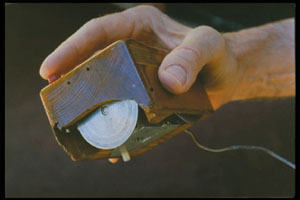Computer mouse
[[file:_SRI_Computer_Mouse.jpg._The_usage_is_not_equivalent_to_the_free_image,_as_it_illustrates_the_technical_details_and_size_of_the_device._-->[[|thumb|right]] ==Computer Mouse ==
A computer mouse is a pointing device that detects two-dimensional motion relative to a surface. This motion is typically translated into the movement of a pointer on a graphical user interface (GUI), allowing for the control and interaction with the computer's user interface.
History[edit | edit source]
The first computer mouse was invented by Douglas Engelbart in 1964 at the Stanford Research Institute. Engelbart's mouse was a simple device with two perpendicular wheels that could track movement in two dimensions. The term "mouse" was coined because the device resembled the shape and size of a real mouse, with the cord resembling a tail.
Types of Computer Mice[edit | edit source]
There are several types of computer mice, each with different technologies and functionalities:
- Mechanical Mouse: Uses a rubber or metal ball that rolls on a surface to detect movement. The ball's motion is translated into cursor movement on the screen.
- Optical Mouse: Uses an LED light and a sensor to detect movement. The light bounces off the surface and is captured by the sensor to determine the direction and speed of movement.
- Laser Mouse: Similar to an optical mouse but uses a laser for more precise tracking.
- Wireless Mouse: Connects to the computer via radio frequency (RF) or Bluetooth technology, eliminating the need for a physical cord.
- Trackball Mouse: Features a ball on top of the device that the user rotates to move the cursor, rather than moving the entire mouse.
Components[edit | edit source]
A typical computer mouse consists of several key components:
- Buttons: Most mice have at least two buttons (left and right) for clicking and selecting items. Some mice also include additional buttons for extra functionality.
- Scroll Wheel: Located between the buttons, the scroll wheel allows for easy navigation through documents and web pages.
- Sensor: Detects the movement of the mouse and translates it into cursor movement on the screen.
- Microcontroller: Processes the signals from the sensor and buttons and sends the appropriate data to the computer.
Usage[edit | edit source]
The computer mouse is an essential input device for many types of software, including operating systems, web browsers, and productivity software. It allows users to interact with graphical elements on the screen, such as icons, buttons, and menus.
Ergonomics[edit | edit source]
Ergonomics is an important consideration in the design of computer mice. Poorly designed mice can lead to repetitive strain injuries (RSIs) such as carpal tunnel syndrome. Ergonomic mice are designed to fit the natural shape of the hand and reduce strain during use.
See Also[edit | edit source]
References[edit | edit source]
External Links[edit | edit source]
Search WikiMD
Ad.Tired of being Overweight? Try W8MD's physician weight loss program.
Semaglutide (Ozempic / Wegovy and Tirzepatide (Mounjaro / Zepbound) available.
Advertise on WikiMD
|
WikiMD's Wellness Encyclopedia |
| Let Food Be Thy Medicine Medicine Thy Food - Hippocrates |
Translate this page: - East Asian
中文,
日本,
한국어,
South Asian
हिन्दी,
தமிழ்,
తెలుగు,
Urdu,
ಕನ್ನಡ,
Southeast Asian
Indonesian,
Vietnamese,
Thai,
မြန်မာဘာသာ,
বাংলা
European
español,
Deutsch,
français,
Greek,
português do Brasil,
polski,
română,
русский,
Nederlands,
norsk,
svenska,
suomi,
Italian
Middle Eastern & African
عربى,
Turkish,
Persian,
Hebrew,
Afrikaans,
isiZulu,
Kiswahili,
Other
Bulgarian,
Hungarian,
Czech,
Swedish,
മലയാളം,
मराठी,
ਪੰਜਾਬੀ,
ગુજરાતી,
Portuguese,
Ukrainian
Medical Disclaimer: WikiMD is not a substitute for professional medical advice. The information on WikiMD is provided as an information resource only, may be incorrect, outdated or misleading, and is not to be used or relied on for any diagnostic or treatment purposes. Please consult your health care provider before making any healthcare decisions or for guidance about a specific medical condition. WikiMD expressly disclaims responsibility, and shall have no liability, for any damages, loss, injury, or liability whatsoever suffered as a result of your reliance on the information contained in this site. By visiting this site you agree to the foregoing terms and conditions, which may from time to time be changed or supplemented by WikiMD. If you do not agree to the foregoing terms and conditions, you should not enter or use this site. See full disclaimer.
Credits:Most images are courtesy of Wikimedia commons, and templates, categories Wikipedia, licensed under CC BY SA or similar.
Contributors: Prab R. Tumpati, MD




